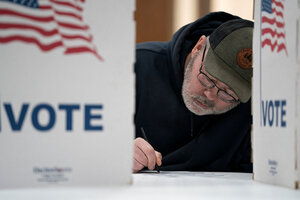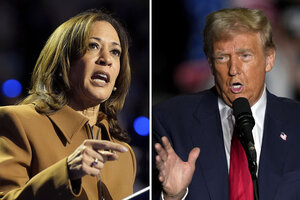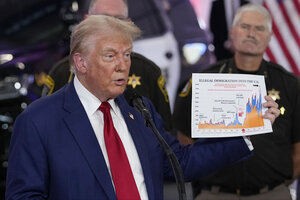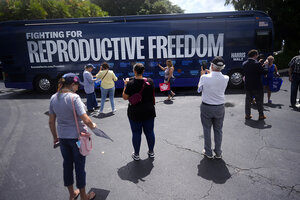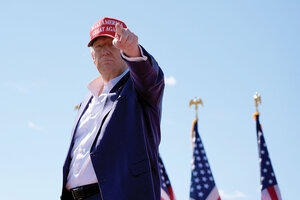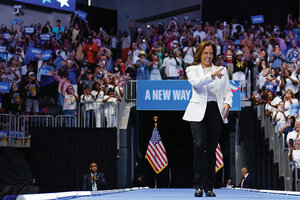Liberal or moderate? Depends which Tim Walz you’re talking about.
| MINNEAPOLIS
In the two weeks since Vice President Kamala Harris chose Minnesota Gov. Tim Walz as her running mate, both campaigns have been scrambling to shape his public image – for better or worse.
Democrats are painting him as a gun-toting, football-coaching, former National Guard member with a moderate track record and a “Midwestern dad” vibe. Republicans say he’s a radical progressive hiding behind camo, who has spoken misleadingly about his military service and pushed his state far to the left in just a few short years.
One thing allies and critics agree on: Mr. Walz changed between his time as a congressman and his current role as governor, from a centrist politician to a markedly more progressive one.
During his 12 years in the House, Mr. Walz, who represented a red district in southwestern Minnesota, was known as an advocate for rural issues and veterans. He was ranked as one of the most bipartisan members of Congress, near the center of the ideological spectrum.
Then as governor, Mr. Walz shifted left after a crucible of a first term shaped by the COVID-19 pandemic and riots that erupted after a police officer murdered George Floyd, a Black Minneapolis-area resident. He enacted a slew of progressive priorities: free school lunches, paid family and medical leave, and free college tuition for some students.
Republicans argue the shift was driven by ambition, as Mr. Walz’s star began to rise in the Democratic Party. Democrats say it’s simply proof that Mr. Walz – who has a higher favorability rating than Ms. Harris, former President Donald Trump, and Mr. Trump’s running mate, Ohio Sen. JD Vance – is attuned to his constituents and adapts to new circumstances.
When the governor takes the stage at the Democratic National Convention Wednesday evening to accept the vice presidential nomination, it will be the biggest moment of his 20-year political career – and a key opportunity to further define himself in the public eye.
“[Democrats] are going to try to define Walz in terms of his congressional career, because he represented a Republican, rural, conservative district. He was bipartisan and had a lot of friends on both sides of the aisle,” says Vin Weber, a Republican strategist and former Minnesota congressman. “Republicans have to define him by the [2020] Minneapolis riots and 2023 legislative session.”
Multiple election wins in farm country
Minnesota’s 1st Congressional District, in a rural area along the state’s southern border with Iowa, is responsible for more than one-third of the state’s agriculture production. That sets its residents apart from the rest of the state; almost 3 in 4 Minnesotans live in urban areas. While Minnesota has the longest Democratic voting streak in presidential contests of any state in the country, Mr. Walz became only the second Democrat elected from his district since the 19th century when he beat a six-term Republican incumbent in 2006. He then won reelection five times – including in 2016, when Mr. Trump won many counties in the 1st district by double-digit margins.
“Our needs down here are different from what someone needs in Minneapolis or on the Iron Range” in northern Minnesota, says Caitlin Nicholson, chair of the Minnesota Democratic-Farmer-Labor Party in the 1st Congressional District. “A good politician listens to the people he is representing. Any shift from Walz is because he listened to the people.”
Mr. Walz was reportedly first inspired to run for Congress when, while teaching and coaching football in Mankato, he took a group of students to a rally for then-President George W. Bush in 2004. Upset at how some of the students were treated at the campaign rally after security saw one of them with a John Kerry sticker, Mr. Walz decided to volunteer for Mr. Kerry’s presidential campaign. Soon after, Mr. Walz launched a campaign of his own.
Controversy over National Guard exit
After serving for more than two decades in the Army National Guard, Mr. Walz retired in 2005 to focus on his campaign. Republicans, and Mr. Vance in particular, have called the timing suspicious, given that his retirement coincided with news of a possible partial mobilization of the Minnesota National Guard to Iraq. The official orders for Mr. Walz’s unit came two months later. Mr. Walz has said it was time to retire and he was ready to serve his country another way, this time in Washington.
Conservatives have also accused Mr. Walz of misrepresenting his service record. He has periodically referred to himself as a command sergeant major. “Coach to the state champs, teacher of the year, command sergeant major,” stated an ad for Mr. Walz’s 2006 campaign, over photos of him in action. Allies say Mr. Walz simply misspoke and that it’s a matter of semantics: He did serve as a command sergeant major but retired one rank below, as a master sergeant.
Despite being a source of recent controversy, Mr. Walz’s service has shaped his political career.
When he launched his first congressional campaign, against Rep. Gil Gutknecht, Mr. Walz hammered the incumbent Republican for voting against a $1,500 bonus for U.S. troops in 2003 – a measure that ended up failing on a tie vote.
“[Mr. Gutknecht] had never worn a uniform but he was making these anti-veteran votes,” says Matt Barron, a Democratic strategist who focuses on rural races and worked on Mr. Walz’s 2006 campaign. And given that Minnesota’s 1st is a “very strong agriculture district,” Mr. Walz also hit his opponent for voting against local water projects. Running as a Democrat in a longtime Republican district was an uphill battle, adds Mr. Barron, but “these things were handed to Walz on a silver platter – and he took advantage of them.”
Once in Congress, Mr. Walz was appointed to the Committee on Veterans’ Affairs, eventually becoming the ranking member. According to GovTrack, 67% of the bills Mr. Walz sponsored while in Congress were related to the armed forces and national security, and 14% were related to agriculture and food.
“As a veteran, I resent what they’re trying to pull” by accusing Mr. Walz of lying about his service, says Steve Mckeown, a Democrat from a southern Minneapolis suburb whose son lives in Mr. Walz’s hometown of Mankato. “He has worked across the aisle and won in a Republican district. … I think he’s a brilliant pick.”
Minnesotans’ mixed views of Walz
Mr. Mckeown spent last Sunday passing out brochures in Minneapolis’ Minnehaha Park, warning voters about Project 2025, a policy blueprint put together by the conservative Heritage Foundation for the next Republican president. Mr. Mckeown says he’s particularly proud of Mr. Walz’s new financial aid programs for farmers.
A hunter, Mr. Mckeown says he respects Mr. Walz’s support of an assault weapons ban – another issue on which the governor’s politics have evolved.
While serving in Congress, Mr. Walz received funding and several “A” ratings from the National Rifle Association. But after the mass shootings in Las Vegas in late 2017 and at Marjory Stoneman Douglas High School in 2018, Mr. Walz says his views on gun restrictions changed. Shortly thereafter, while running for governor, Mr. Walz cosponsored a bill to ban assault weapons after opposing an assault weapons ban in 2009. “I’ve seen enough of this carnage,” Mr. Walz said at the time. Following his reelection as governor in 2022, when Democrats also won majorities in both houses of the Minnesota legislature, he signed a gun safety measure into law requiring universal background checks.
“I believe people grow and change,” says Terry Fisher, a native of Minneapolis who was hosting a picnic for old friends in Minnehaha Park earlier this week. “It’s good to be open.”
“I respect him for that,” says Vanessa Seng, a Democrat from Inver Grove Heights, south of St. Paul. “He saw what he had to work with and got things done.”
With Democratic control of the state legislature, Mr. Walz got many things done over the past two years – a record both sides have referenced in ads. “[Y]ou don’t win elections to bank political capital,” Mr. Walz wrote on X last year. “You win elections to burn political capital and improve lives.”
In 2023 alone, the governor passed laws to provide free breakfast and lunch to Minnesota students, legalize recreational marijuana use for adults, create a state paid leave program for medical needs and childbirth, provide free tuition at Minnesota universities for students whose families earn less than $80,000, phase out all carbon-sourced electricity in the state by 2040, and protect access to reproductive health, including abortions, statewide.
“These are extreme positions,” says former Minnesota Sen. Paul Gazelka who served as Republican majority leader during Mr. Walz’s first term as governor.
During that first term, “I could push him and we could find a place that maybe all of Minnesota wasn’t thrilled with, but we could all feel like [it] was good government,” says Mr. Gazelka. “I don’t think his country roots reflect where he is politically.”
Even in the liberal Twin Cities, where supporters have handwritten “WALZ” on makeshift Harris lawn signs, not everyone is pleased with their governor.
“He’s too liberal,” says Kevin Christian, a Republican who criticizes Mr. Walz for flip-flopping on gun rights and disagrees with several other of his recently passed progressive policies.
Helping Democrats expand their reach?
But to some Democrats like strategist Mr. Barron, Mr. Walz’s progressive politics and country roots make for a powerful combination, allowing him to connect with voters that Democrats have struggled to reach in recent years.
“Republicans have mined rural votes on the cultural, hot-button issues. Where they are vulnerable is the meat and potatoes issues: broadband, agriculture, the Infrastructure Act. This is what rural voters care about,” says Mr. Barron. “Democrats have turned their back on rural America, there is no sugarcoating it. ... You can squeeze the washcloth to get every vote you can out of those urban areas but eventually you max out.”
Mr. Walz can be deployed to these areas and speak authentically, says Mr. Barron. He envisions the campaign sending Mr. Walz to high school football games in rural swing state areas like western Pennsylvania. “If he goes to Friday night lights and the high school football games, if they run an ad in the Erie and Pittsburgh markets with a whistle around his neck with high school kids, that’s really going to resonate.”
The next day, Mr. Walz did just that.
Story Hinckley reported from Richmond, Virginia, and Colette Davidson from Minneapolis.








